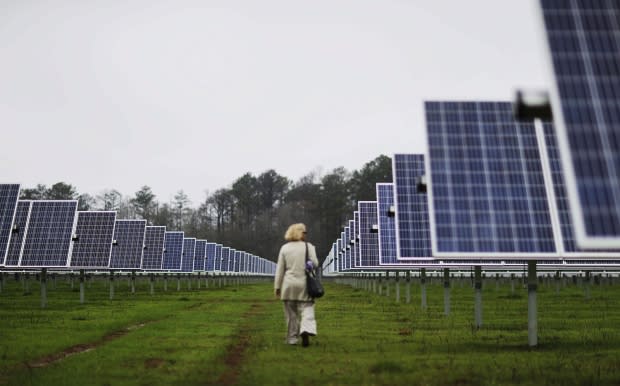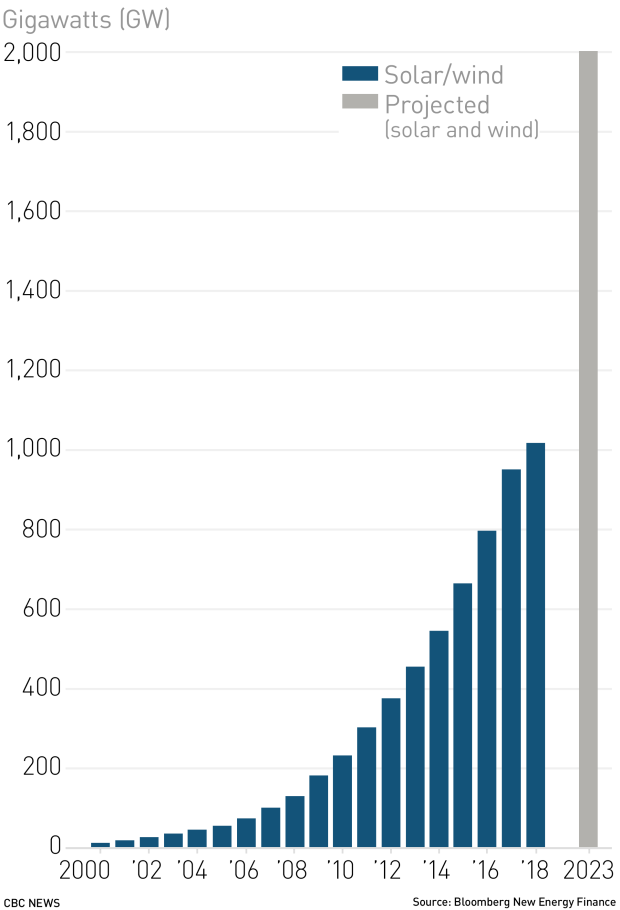Your smartphone is burning a lot of carbon
This is our weekly newsletter on all things environmental, where we highlight trends and solutions that are moving us to a more sustainable world. (Sign up here to get it in your inbox every Thursday.)
This week:
Do you know your smartphone's carbon footprint? You should
Green investing is a feel-good moneymaker
Wind-solar power just reached a major milestone
Reader tips on reducing your environmental footprint
Your smartphone use is burning a lot of carbon

We all do it — snuggle up in bed or on the sofa, or maybe during our daily commute, and watch a video clip on our phones. We may even watch an entire movie that way.
It turns out this common, seemingly innocuous act — and our internet use more generally — is leaving a lasting impact on the environment.
In a study published earlier this year, two professors at McMaster University in Hamilton looked at the carbon footprint of the information and communications technologies industry (ICT), which includes the internet.
And it's a Bigfoot-worthy print.
In the study, the ICT "universe" includes computers, phones and laptops; telecommunications structures, such as satellite dishes and routers; and, crucially, data centres, the backbone of the internet. (What it didn't include is the Internet of Things, computers in cars and smart TVs. At the moment, that type of data use is still somewhat new, though the study's authors say it would be figured into future studies.)
McMaster associate Prof. Lotfi Belkhir and his colleague Ahmed Elmeligi found that ICT is responsible for about 1.5 per cent of worldwide carbon emissions. As a comparison, the energy sector accounts for roughly 27 per cent, while agriculture, forestry and other land use make up 25 per cent.
The study suggests that by 2040, ICT's carbon emissions could account for as much as 14 per cent, which is roughly where the transportation industry is right now.
It might surprise you to know that. The findings surprised Belkhir, too.
Smartphones were by far the worst contributors to tech's carbon footprint. That's because of several factors, including the mining activity needed to extract the metals needed to make our phones. For one thing, your phone requires almost 10 times as much precious metals as a laptop or desktop computer.
Also, we just use our phones way more often.
Data can seem invisible to us — especially if you're on an unlimited plan — but every email, tweet and video lives on a server. With all the servers humming away in data centres, those giant buildings need to be cooled — and the emissions are through the roof.
The increasing prevalence of smartphones is not helping. As the number of users is only likely to grow, Belkhir said we need to rethink how we power communications.
"What needs to change is the way we're running our data centres," he said. One of his study's recommendations: Run those data centres exclusively on renewable energy.
Belkhir believes this is completely doable. He said solar energy is getting ever cheaper, and server farms tend to be located outside urban centres, which are ideal locations for solar and wind installations.
He said consumers also have a role to play. For one thing, he said we should keep our existing phones longer, which would curtail all that mining activity. A more immediate suggestion, however, is for us to reduce our internet use — particularly video, which eats up a ton of data.
That means thinking twice before downloading and watching a movie on our phones.
Said Belkhir, "Maybe going with friends to the movies and watching a movie there on the big screen is actually more environmentally friendly than each one of them watching it on their smartphones."
— Nicole Mortillaro
Missed any issues of What on Earth?
You're reading the fifth issue of our newsletter. If you missed any issues, they also live online:
As always, feel free to send comments to whatonearth@cbc.ca.
The smart money is in green investments

New numbers this week reveal a trend that may come as a surprise to many environmentalists: The world's richest investors are finally embracing their inner treehugger.
Canada's Responsible Investment Association (RIA) says that last year, for the first time, more than half the money invested in Canada went to sustainable investments.
By RIA's math, that's more than $2 trillion. And numbers out of the U.S. are even more eye-popping. The biennial report from the Forum for Sustainable and Responsible Investment calculates that there's $12 trillion US being put to work on investments in renewable energy and other initiatives seeking to mitigate the effects of climate change.
That's music to the ears of Toronto-area investment coach Tim Nash, who said that for too long, his clients had a hard-wired bias against green investments, assuming that anything "sustainable" was somehow inferior in the core aim of making money.
"They just assume performance is going to be worse," Nash said this week, "against all evidence to the contrary."
For a long time, green investing was seen as something only idealistic hippies were into — not ruthless, profit-hungry hedge funds. But saving the world, it seems, is good for business, which is why the smart money on Wall Street and Bay Street wants in.
Even the capitalists who run Canada's pension plan are getting in on the action. The Canada Pension Plan Investment Board (CPPIB) has earmarked $3 billion in the past two years to green energy projects.
For Ben Lambert, CPPIB's interim head of sustainable investing, the reason is simple.
"Our job is to maximize returns without risk of loss for generations to come … and the research shows that companies that do well on these sustainability issues extend their corporate life and are more likely to create value over the long term."
Which is why these days, big investors are more likely to put money into an oil company that's readying for a world without oil than they are to gobble up a pollution-belching mining company that has no plan beyond its next quarterly results.
"It's about doing the right thing and generating returns," Lambert said. "It's a win-win situation."
— Pete Evans
The Big Picture: Worldwide solar and wind power
In August, research firm Bloomberg New Energy Finance reported that the combined installed capacity of solar and wind power globally had surpassed one terawatt, or 1,000 gigawatts. (That's roughly the total power capacity of the U.S.) It took about two decades to get here, but Bloomberg NEF estimates it will only take until the middle of 2023 for this figure to double — and that installing the second terawatt will cost 46 per cent less than the first.

Hot and bothered: Provocative ideas from around the web
You're doing your part

In our last newsletter, we asked you to share some of your personal initiatives in reducing your carbon footprint. And you kindly obliged.
Here are some of your examples. We will continue to publish other reader tips.
Claudette Preece of Courtenay, B.C., wrote:
"We have had a heat pump for 16 years and replaced it last winter with a model that will withstand minus–20 temperatures.
"We installed solar panels about three years ago. Thirty-six of them. We got rid of our hot water heaters and installed a gas-fired hot water on-demand system. We have gone from our 14-year-old gas-driven car to a Mitsubishi PHEV. Wanted one that did more mileage on battery but the waiting list was eight months. This does enough mileage on battery to do all my errands and shopping trips. On long trips, if the engine kicks in, it is to recharge the battery, not to run the engine. Since purchasing it May 1st, we have filled it up with gas about five times, and on none of those occasions was it completely empty."
One reader, who wished to remain anonymous, had a raft of good suggestions, including:
Using reusable grocery bags, and keeping them in your trunk "so you never forget them!"
Carrying a reusable water bottle around at all times, saying there is no need for bottled water, because "municipal tap water is safe and delicious."
She has LED lightbulbs and low-flow showerheads installed at home.
She also does clothes swaps, in which she and friends get together and exchange gently used clothing.
She also made a couple of bigger points:
"The 3 Rs are real, and "reduce" is so important. Shop less. Bring less stuff into your house."
And:
"I get out in nature as often as I can, as someone who works behind a desk in an office, to admire its beauty and appreciate it, and improve my physical and mental health. Knowing more about the environment and loving all of its wonderful qualities helps you understand why it must be preserved and protected."
Amen to that.
Finally, Chélie Elsom of Salmon Arm, B.C., wrote in to tell us that she has been so "passionate about plastic pollution" that she started an online petition.
Petition 1834, which is sponsored by Green Party MP Elizabeth May and slated to be tabled in the House of Commons in January 2019, calls for a "National Plastic Strategy." That includes a ban on "the manufacturing, distribution and use of all plastics that cannot be recycled" and a "Zero Plastic Waste Canada" by 2030, where all plastic packaging is 100 per cent recyclable, reusable or compostable.
Stay in touch!
Are there issues you'd like us to cover? Questions you want answered? Do you just want to share a kind word? We'd love to hear from you. Email us at whatonearth@cbc.ca.
Sign up here to get What on Earth? in your inbox every Thursday.
Editor: Andre Mayer | Logo design: Sködt McNalty

